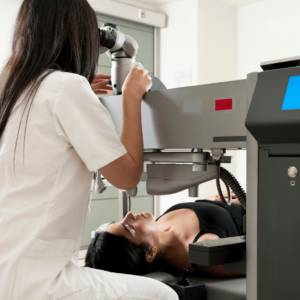What is Astigmatism?
Astigmatism is an eye condition that distorts a person’s vision, often caused by an irregularly shaped cornea or lens. The disorder causes light to be bent differently on different parts of the cornea, causing blurry vision.
It is common in children and adults and can affect one or both eyes.
Fortunately, several corrective methods can improve the vision of individuals with astigmatism, such as eyeglasses, contact lenses, or even surgery.
Astigmatism can be caused by either an unevenly shaped cornea, known as corneal astigmatism, or by an unevenly shaped lens, referred to as lenticular astigmatism. The best way to visualize the irregular curvature of a cornea or lens affected by astigmatism is to imagine a football rather than a basketball or soccer ball.
Astigmatism is an eye condition where the cornea or lens does not have an even curvature. This causes light to split and focus in two places, either in front of or behind the retina. One can only have a sharp vision if the focal point hits the right place. Instead, they experience blurry vision as a result of astigmatism.
How Does LASIK Treat Astigmatism?
Astigmatism can be treated through LASIK, a laser eye surgery.
During LASIK, a laser is used to reshape the cornea to correct the irregular shape and improve vision. The specific type of laser used for astigmatism is called a toric laser, which can target and correct the areas of the cornea causing astigmatism.
LASIK is an outpatient procedure that usually takes less than 30 minutes per eye. It is generally considered a safe and effective treatment for astigmatism, with a high success rate.
Before making any decisions, it is essential to talk with an ophthalmologist about the details and possible side effects of such procedures.
Advantages of LASIK for Astigmatism
There are several advantages of LASIK for treating astigmatism:
- The LASIK procedure is typically quick, painless, and requires minimal recovery time. An experienced surgeon can perform the entire process in less than 30 minutes per eye, with little or no discomfort experienced by the patient.
- LASIK is noninvasive – the only alteration made is the reshaping of the cornea through the application of lasers.
- Allowing people to reduce or eliminate their need for eyeglasses or contact lenses. This can significantly improve their quality of life by providing a sharp, clear vision and greater independence from glasses or contacts.
- It has a high success rate. Most people who have LASIK to treat astigmatism experience significant improvement in their vision, and many achieve 20/20 vision or better.
- It is a safe and long-lasting solution that can improve vision given the necessary practice and follow-up visits after the procedure. It can provide relief from glasses or contact lenses for many years, usually several decades into the future.
- It can be combined with other refractive procedures. LASIK can be combined with other laser procedures, such as PRK and LASEK, to correct other vision problems like myopia and hyperopia.
LASIK may not be suitable for everyone, and you should consult your doctor to understand if you are a good candidate for the procedure.
Are There Types Of Astigmatism That LASIK Can’t Fix?
While LASIK is an effective treatment for many people with astigmatism, it may not be suitable for everyone. Certain types of astigmatism may not be able to be corrected with LASIK alone or may require additional treatments.
- High levels of astigmatism: LASIK may not be effective for people with very high levels of astigmatism, as the laser may not be able to reshape the cornea enough to correct the irregular shape.
- Dry eye syndrome is a condition in which the eyes cannot produce enough lubrication to remain comfortable. This can occasionally be a side effect of LASIK, making it essential to get dry eye treatments before opting for the procedure.
- Corneal scarring: If the cornea has scarring from a previous injury or infection, the laser may not be able to reshape the cornea properly.
- Keratoconus: This is a condition where the cornea thins and bulges outward. LASIK is not recommended for people with keratoconus.
- Other conditions: Some other conditions, such as autoimmune disorders, certain medications, and some other eye conditions, may make LASIK unsuitable
If LASIK is not appropriate for your specific case, other options, such as PRK, LASEK, or Phakic IOLs ( intraocular lenses), can be considered. Your eye doctor can guide the most appropriate treatment for your condition.
Am I a Good Candidate for LASIK Astigmatism Surgery?
Several factors determine whether someone is a good candidate for LASIK astigmatism surgery, including:
- Age: You must be at least 18 years old to have LASIK, and your vision should be stable for at least one year before the procedure.
- Astigmatism: You should have a measurable level of astigmatism that can be corrected with LASIK.
- Overall eye health: You should have no existing eye conditions or diseases that may affect the outcome of the surgery.
- Pupil size: Your pupils should be of normal size and should normally react to light.
- Corneal thickness: Your cornea should be thick enough to withstand the laser reshaping required for LASIK.
- Dry eyes: You should have enough tears to keep your eyes lubricated and comfortable. If you have dry eyes, your eye doctor may recommend treating this condition before having LASIK.
- Lifestyle: these treatments can improve natural vision and reduce dependence on corrective lenses, they may not provide perfect 20/20 vision, and you may need to wear eyeglasses or contact lenses for some activities.
Side Effects of LASIK For Astigmatism
LASIK is generally considered a safe and effective procedure for treating astigmatism, but like any surgery, there are potential risks and side effects.
Common side effects of LASIK include:
- Dry eyes: Some people may experience dry eyes after LASIK, which can cause discomfort or blurred vision. This side effect is usually temporary and can be treated with eye drops.
- Glare or halos: Some people may experience glare or halos around lights at night, especially when driving. This side effect is usually temporary and may improve within a few weeks.
- Under or over-correction: In some cases, the laser may not reshape the cornea enough, resulting in under-correction or too much resulting in correction; this can be corrected with an additional procedure.
- Epithelial ingrowth: In rare cases, cells from the eye’s surface (epithelium) may grow under the flap after LASIK. These cells can cause problems with vision and may require additional surgery to remove them.
- Infection: As with any surgical procedure, there is a small risk of infection, which can be treated with antibiotics if caught early.
It is essential to discuss the potential risks and side effects of LASIK with your eye doctor before the procedure and to have realistic expectations about the outcome of the surgery.
Recovery Time For LASIK on Astigmatism
After LASIK surgery to correct astigmatism, most people can return to their daily routines in just a few days. Recovery time is usually short, and many patients experience excellent vision improvements soon after the procedure.
Immediately after the procedure, your eyes may feel dry and itchy, and you may experience some mild discomfort and sensitivity to light. Your surgeon may give you eye drops to help with discomfort and prevent infection.
You will be given protective shields to wear over your eyes for the first few days to help protect them while they heal. You’ll be asked to avoid rubbing your eyes and avoid strenuous activities or swimming for at least a week.
Most people can return to work and other normal activities within a day or two of the procedure. You’ll likely be able to see well enough to drive within a day or two, but you may be asked to avoid driving at night because of the glare or halos that some people experience in the first few days after the procedure.
The healing process after astigmatism correction surgery may vary from person to person, so it’s essential to follow the post-operative care instructions provided by your surgeon to minimize risks and get the best possible outcome.
It will take a few weeks for your eyes to heal fully and your vision to stabilize. You will have follow-up appointments with your surgeon to monitor your progress and check for complications.
How Much Does LASIK Cost for Astigmatism?
The cost of LASIK for astigmatism can vary depending on several factors, including the surgery center’s location, the surgeon’s experience, and the technology used.
On average, the cost of LASIK for astigmatism ranges from $1,500 to $3,500 per eye, but it can be higher or lower depending on the abovementioned factors. Some insurance plans may cover the cost of LASIK or a portion, but most people pay for the procedure out of pocket.
It’s essential to research, select a reputable and experienced surgeon and a reputable clinic, and ensure you understand all the costs involved.
You should also ask the surgeon about any financing options available and check if the clinic offers a guarantee, which will allow you to come back for free touch-ups if you’re not satisfied with the result or if there are complications.
It’s important to remember that LASIK is a significant investment, and you should not compromise the quality of the procedure for the price.
Is LASIK Safe For Astigmatism?
LASIK is considered to be a safe and effective procedure for treating astigmatism. The procedure has been performed successfully on millions of people worldwide and has a high success rate. Most people who have LASIK to treat astigmatism experience significant improvement in their vision, and many achieve 20/20 vision or better.
However, as with any surgical procedure, there are risks and potential complications associated with LASIK. The most common risks include dry eyes, glare or halos, under or over-correction, and infection. These risks are generally low, and most people do not experience serious complications.
It’s essential to have a thorough consultation with a qualified and experienced eye doctor before the procedure to ensure you understand all the benefits and risks and that you’re a good candidate for the procedure. Your doctor will be able to evaluate your eyes and your medical history and will be able to advise you on the best course of treatment for your specific case.
Also, it’s essential to follow the post-operative care instructions provided by your surgeon to minimize the risks and ensure the best possible outcome.
Are There Alternative Treatments For Astigmatism?
There are alternative treatments for astigmatism, which include:
- Glasses or contact lenses are the most common and traditional ways to correct astigmatism. Glasses or contact lenses can correct the cornea’s irregular shape, resulting in clear vision.
- PRK: This is a laser eye surgery similar to LASIK, but instead of creating a flap in the cornea, the laser is applied directly to the cornea’s surface to reshape it.
- LASEK: This is a laser eye surgery similar to PRK, but instead of removing a layer of the cornea, the laser is applied to the cornea’s surface after the outer layer of the cornea (epithelium) is lifted.
- Phakic IOLs (intraocular lenses): small artificial lenses that can be surgically inserted into the eye for vision correction purposes rather than wearing corrective eyeglasses or contact lenses. Typically implanted in front or behind the eye’s natural lens, phakic IOLs offer an alternative to refractive surgeries such as LASIK and PRK and provide patients with a more holistic visual correction solution.
- Orthokeratology: is a type of corrective eye treatment which uses specially designed contact lenses to reshape the cornea. Ortho-k lenses provide a safe and effective way to reduce or even eliminate the need for eyeglasses or daytime contact lenses during the day. These lenses are worn overnight while sleeping and temporarily reshape the cornea so astigmatism can be corrected.
It’s important to consult with a qualified eye doctor to understand which treatment is best for you and your specific case. Factors such as astigmatism, overall eye health, and personal preference will be considered when determining the best treatment option.
Are the Results of LASIK on Astigmatism Permanent?
The results of LASIK on astigmatism are typically long-lasting, with most people experiencing stable vision for many years after the procedure. However, it’s important to note that the results of LASIK are not necessarily permanent, and there is a small chance that the shape of the cornea may change over time, leading to a recurrence of astigmatism or the need for additional treatment.
It’s also important to note that the procedure does not prevent the normal aging process of the eyes, so presbyopia (the age-related loss of the ability to focus on close objects) may still occur and may require the use of reading glasses.
Also, it’s important to remember that LASIK cannot prevent the development of other vision conditions, such as cataracts, which may require additional treatment in the future.
It’s important to remember that this procedure may only partially resolve your vision issues, and you may still need to wear contact lenses or glasses for certain activities.
You must have regular check-ups with your eye doctor to monitor your eye health and ensure that astigmatism does not go untreated.






